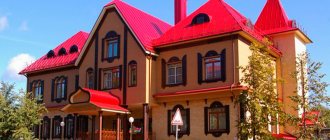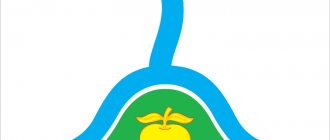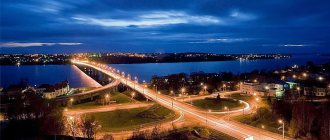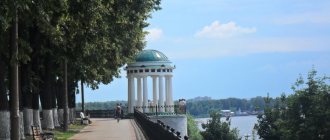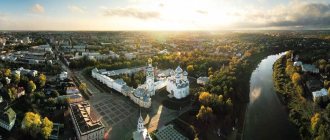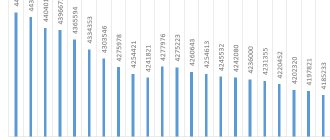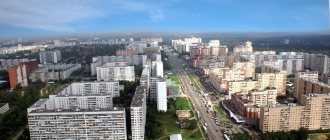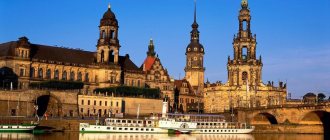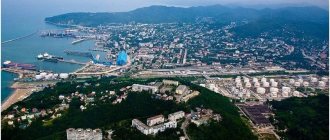The territory of the Ivanovo region has been inhabited since the Stone Age, but the appearance of the first significant settlements that have survived to this day dates back to the 13-15 centuries. Despite such a long history of development, the population of the region cannot be called large: 1,004,192 people on an area of 21,437 km². The density is also low: 46.84. For comparison, in the neighboring Yaroslavl region the figure is 34.82, and in the most populous Moscow region it is 171.44. Economic indicators leave much to be desired: GDP per capita is the lowest among Russian regions: three times reduced compared to the national average.
The most significant cities of the Ivanovo region by population
Although there are only 17 cities in the region, they account for the bulk of the population, accounting for 82.33%, according to 2022 information. The region also has 13 urban-type settlements and 31 workers’ settlements. The region cannot boast of millions of people. The largest entity is the capital Ivanovo, where 406,113 people live. The rest of the top ten offer even more modest figures: none of them reach the 100,000 mark.
The list of the most densely populated entities of the subject includes:
- Ivanovo - 406 113.
- Kineshma - 83,871.
- Shuya - 58,723.
- Vichuga - 34,868.
- Furmanov - 34,309.
- Teykovo - 32,791.
- Kokhma - 30,316.
- Springs - 24,662.
- Privolzhsk - 15,824.
- Yuzha - 12,834.
Ivanovo is the most densely populated settlement
The capital of the region, Ivanovo, ranks first in the ranking of the largest cities in the Ivanovo region by the number of residents with an indicator of 406,113. The area of the capital is small - 104.84 km², which provides a rather high density, by provincial standards, of 3,873.65. Of course, the Moscow figures are many times higher - 4,925.19. However, for example, compared to neighboring Kostroma, where the figure is 1,918.89, Ivanovo will seem like a fairly densely populated place.
Rapid growth in numbers occurred during the Soviet period:
- 1917 — 174 400;
- 1939 — 285 182;
- 1959 — 336 161;
- 1990 — 480 000.
1991 became special for Ivanovo: the maximum number of residents was recorded - 482,000. However, after the collapse of the USSR, the figures began to fall rapidly: over the next 25 years they decreased by 76,000. However, the city of brides cannot be called a remote province: in the all-Russian ranking of settlements by the number of residents, it ranks 49th out of a possible 1113.
Industry is poorly developed: even the weaving glory of the settlement has sunk into oblivion. Ivanovo is no longer considered the center of the textile industry, since most of the factories could not withstand the new rules of the game of the capitalist world. However, small textile enterprises and sewing cooperatives are still operating. The chemical, food, trade and service industries are developing. Despite this, the standard of living of Ivanovo residents remains at a rather low level, although the capital, by the standards of the region, is the most prosperous settlement. The most ambitious residents of villages and small towns in the region come here for a better life, which is largely supported by demographic indicators.
Historical sites and museums
Balmont Literary and Local Lore Museum
Address: pl. Lenina, 2 Phone: Website: https://balmontmuseum.ru/ Opening hours: 10:00-17:00 Tue-Fri; 10:00-16:00 Sat, Sun; Mon – closed
The museum is located in the historical part: in the suburb next to the Kremlin. The former building of the Shuya City Duma, the style is neo-Russian.
The museum opened in 1968 to highlight local folk history. Received its current name in 2007. The museum presents various exhibitions dedicated to the nature of the region, the history of the city, and the life and work of the poet.
The exhibition presents the pedigree of the Balmont family, documents and photographs of the poet and his parents, collections published during his lifetime, cutlery with initials, and a silver pen. The museum also houses collections of porcelain, works by Makovsky and Levitan.
Since 1989, the museum has hosted Balmont readings, competitions and children's festivals, and master classes.
Shuya Museum and Cultural Center named after. M. V. Frunze
Address: st. M. Belova 11/13 Phone: 8 (49351) 3-86-20 Opening hours: 10.00-17.00 Tue-Fri; 10.00-15.00 Sat, Sun; Mon – closed
One of the oldest museums in the Ivanovo region, unique in its profile - a revolutionary museum dedicated to the life of M. V. Frunze, a Soviet figure and revolutionary.
The main exhibition of the museum is “Time and Fate”, dedicated to the history of the city and the activities of the Red Guard. Collections include Frunze's photo-documentary collection and posters from the World Festival of Youth and Students (1957), held in Moscow. Also presented is a model of the Shuya Kremlin of the 15th century.
The museum's funds contain works by Soviet artists, collections of bottles from the 19th and 20th centuries, posters, and stamps.
Soap Museum
Address: 2nd Dubkovskaya, 33A Telephone: Website: https://milce.ru/ Working hours: 10:00-17:00 Sat-Sun, on weekdays - by agreement
The museum opened in 2014. Soap making in Shuya began in the 17th century; in total there were more than 10 soap factories.
Under Catherine the Great, the whole country knew about the excellent quality of local soap. The coat of arms, approved in 1781, confirms this fact.
The museum's collection contains ancient recipes and the official seal of the chairman of the nobility. The museum conducts master classes on soap making (from 10 people), and since 2010 the city has hosted a soap festival.
Museum State Wine Warehouse No. 3
Address: st. Zavokzalnaya, 17 Telephone: Opening hours: 10:00-17:00 Mon-Sat, Sun – closed
The history of the production of alcoholic beverages in Shuya is presented in this museum. Despite the small size of the exhibition, ancient recipes, a collection of equipment and bottles are stored here.
A company store is located nearby, attracting a large number of customers.
The group tour includes a visit to the production facility, a film and a tasting.
Pavlovsky Cultural Center (Estate of manufacturer M. A. Pavlov)
Address: 1st Moskovskaya, 38 Telephone: 8 (49351) 4-84-98 Opening hours: 8:00-18:00 Mon-Sun Cost: 60 rub.
The architectural landmark of Shuya, a monument of the 19th century, has preserved the internal and external appearance of that time.
The building was built in a palace style, which is rare for provincial cities. The complex is dedicated to the life and work of M. A. Pavlov, philanthropist, merchant and industrialist. He provided jobs for hundreds of townspeople, built churches and provided assistance to schools.
The cultural complex hosts theatrical performances, charity evenings, receptions of official delegations, classical music evenings and children's parties.
Water tower
Address: st. Sverdlova 1/36
In 1883, one of the first water pipes in the Russian Empire was opened in Shuya, funded by donations from residents. The architect of the tower was V. O. Sherwood, the author of the Historical Museum in Moscow.
The tower is a water temple decorated with brickwork. The style of construction is Russian.
For some time the tower was used as fire protection.
Cart scales
Address: Central Market Address: Central Market
The building, built at the end of the 18th century in the style of late classicism, has a general appearance similar to an ancient Greek temple.
Built to determine the weight of carts with goods. In Shuya, scales were considered “zero kilometer”: the flagpole rising on the building had the appearance and color of a milepost.
Restoration work began in 2007, and now the scales are one of the city’s decorations.
Remains of the prison castle
Address: st. Soyuznaya, 15
The first information about the city prison (prison) is found in documents of the 16th-17th centuries. The structure was located on the site of salt barns.
The prison building was destroyed several times by fires and by the Poles, after which it was restored and rebuilt. There is a stone church near the prison, built at the expense of the merchant I. S. Gundobin.
Famous historical figures whiled away their time within the walls of the fort: the boyars of Ivan the Terrible, opponents of Boris Godunov, revolutionary M. V. Frunze. Today the building is used for commercial purposes.
Kineshma is a quiet provincial town with a declining population
The second place in the list of the largest cities in the Ivanovo region in terms of the number of inhabitants is occupied by the town of Kineshma, located on the right bank of the Volga, where 83,871 people live. One of the oldest cities is mentioned in documents from 1429, but a settlement was founded in its place much earlier. During the reign of Ivan the Terrible, the small settlement had the status of a settlement, then grew to a settlement, and in 1616 it became the center of the Kineshma district. However, despite its regional significance, it received city status only a century and a half later, in 1770.
By the standards of the province, by the standards of the province, before the advent of Soviet power, Kineshma’s industry was considered well developed, involved in the following areas:
- mechanical engineering;
- textile;
- food production;
- electrical engineering;
- chemical industry.
However, the town experienced truly rapid development during the Soviet era. Thus, the Avtoagregat enterprise produced brake systems for Moskvich vehicles, and DSK provided neighboring regions with materials for the construction of housing. With the collapse of the Union, the vast majority of Kineshma enterprises closed, which affected the number and quality of life of the townspeople. Since 1992, the number of inhabitants of the town has been steadily declining: the loss was more than 20,000.
Although Kineshma occupies second place in the ranking, none of the problems of large cities are typical for it. This is a quiet and sleepy place with significant amounts of private residential development. Traffic jams, air pollution, crowds on public transport during rush hour can be found in the capital of the region, but this provincial town is far from such problems.
Sights of the city of Shuya
The map of Shuya with streets allows you to see where all the iconic places of this ancient city are located.
- One of the most interesting places is the soap museum , where you can not only learn about the history of local soap making, but also take part in the preparation of this product yourself.
- Shuya is the birthplace of the famous Symbolist poet of the Silver Age K. Balmont, in whose memory the Literary Museum named after him operates. The museum building is an architectural monument of the pseudo-Russian style.
- Of great interest are the remains of the city prison , which has long been one of the symbols of Shuya. It became famous for its prisoners - at one time, eminent boyars of the era of Ivan the Terrible and the Soviet military leader M. Frunze were imprisoned here.
- On the territory of the city you can see a monument to the clergy and laity of the Russian Orthodox Church who fell during the years of Bolshevik persecution.
- Shuya is famous for its churches - here is the temple of St. Seraphim of Sarov , as well as the Transfiguration Cathedral.
- The Ivanovo Calico Museum will tell you about the origins, development and achievements of the craft, which has become the hallmark of the region.
Shuya - the former weaving capital
Shuya is located near the capital, only 32 km away, but the number of inhabitants is approximately 7 times less. The population density is also one and a half times lower than Ivanovo, amounting to 1,763.98. Archaeological finds in these places indicate the formation of a settlement at the turn of the 10th-11th centuries, but the first reliable mentions date back only to the beginning of the 15th century, when the famous and influential princes Shuisky began to represent their interests here.
Like most other modern cities, Shuya's growth peaked during the Soviet period. By the end of the era in 1989, 72,000 Shuyan lived here compared to 19,600 in 1987. Industry is poorly developed, since new economic rules deprived the town of its status as a textile capital. Today there is only one weaving factory and 7 more relatively large enterprises.
Shuya on the map of Russia, geography, nature and climate
Shuya is located between the Klyazma and Volga , it is crossed from north to south by the Teza River , in addition, its tributary Sekha .
The city is located in a temperate continental climate zone with pronounced seasonal weather changes. The coldest month is January (-12.1°C), and the warmest month is July (+18.1°C). Due to the constant activity of cyclones, this area is characterized by frequent changes in weather patterns. The maximum amount of precipitation occurs in the summer.
Shuya is located at the junction of two natural zones - mixed forests and European taiga.
Vichuga is a single-industry town with no real prospects
The number of people living in Vichuga is small - 34,868. Moreover, since 1989 there has been a process of steady decline in the number of city residents, which has reduced the figure by 15,000.
However, city status was received only in 1925, as industry began to develop rapidly, the foundations of which had been laid a century earlier by local merchants, factory owners, and simply enterprising people. Today there are several industrial enterprises operating in Vichuga. Tourists are attracted by the remarkable merchant architecture.
Churches and Temples
Bell tower and Resurrection Cathedral
Address: Green Square, 4
The most famous religious building is Shuya. The temple was founded in 1799; the townspeople made a great contribution to the construction: they actively collected donations.
The belfry, 106 m high, is recognized as one of the tallest in Russia, standing separately from the cathedral.
The construction of the temple was entrusted to Maricelli, who was invited from Italy, but the supporting structure of one of the tiers could not stand it. The foreign master fled in fear. Construction was transferred to the simple peasant Savvatyev and the architect Petrov. The image of the Shuya Bell Tower was placed on the labels and logos of local enterprises.
Church of the Intercession
Address: Soyuznaya, 1
The construction of the temple took place in 1754 on the site of a wooden cathedral church. Previously, in ancient times, there was a cemetery next to the cathedral.
In the 17th century there were two churches on the territory: Aleksievskaya and Pokrovskaya. The Church of the Intercession kept an ancient selection of icons (XVI-XVIII centuries), the library contained a collection of royal manifestos, decrees and the Gospel of the 16th century.
